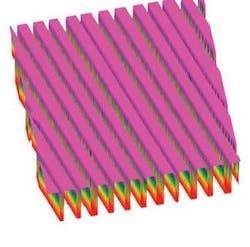
Discussed for some four decades as a theoretical possibility, the first mirrorless optical parametric oscillator (OPO) has now been demonstrated by researchers in the Applied Physics Department at the Royal Institute of Technology (Stockholm, Sweden).1 The breakthrough creates a compact, easy-to-align, less expensive OPO design that opens numerous pathways in both laboratory and field or portable applications.
Optical parametric oscillators are light sources that split a pump photon into two photons of lower energy within a nonlinear material (usually a crystal). Unlike lasers, OPOs require a high-intensity pump source that has high spatial coherence (commonly a diode-pumped solid-state laser) and often rely on a complex and bulky system of mirrors and other optics to achieve the desired gain profile. Despite this complexity, OPOs enable scientists to access wavelengths in the mid- to far-infrared or terahertz spectral regions and enable wavelength tunability over a broad spectral range-a difficult feat for conventional non-OPO laser sources.
The trick to a more-user-friendly OPO, reports the team, is in the crystal. The researchers make use of an effect called quasi-phase-matching, a means of manipulating the phase-matching conditions within a nonlinear material (see also “Quasi-phase-matched DFG lasers for sensing enter the market,” p. 103). In the mirrorless OPO, the two photons split from the pump radiation counterpropagate; one along the pump direction, one against it. These counterpropagating beams automatically set up a distributed feedback, eliminating the need for an external cavity to establish the dynamics. The whole OPO, then, exists within the crystal itself. However, the momentum mismatch is enormous, requiring a concomitant birefringence in the crystal that can’t be found in nature. The way to get around that requirement is to induce a periodic change in the nonlinear susceptibility of the crystal, on a scale of about half the wavelength of the pump. This induced “susceptibility grating” effectively resets the phase mismatch to zero at every cycle, resulting in an efficient process.
Fine-scale periodic poling
Potassium titanyl phosphate (KTP) crystals are an attractive option for the task. Their growth properties make them amenable to periodic poling, the process of growing alternating layers that results in a periodic susceptibility. The team fabricated a periodically poled KTP crystal with a period of 800 nm, which when pumped with 1 kHz, 812 nm picosecond pulses, became a one-part OPO.
The reason that it took 40 years to realize the idea is that fiddling with the susceptibility on that scale is no easy task; the expertise is in knowing how to reliably control the crystal properties on such a small scale. “When we started pumping the crystal, none of us believed that it would work,” says Carlota Canalias, co-author of the study.
But it did work, and the researchers quickly discovered a few physical properties of their mirrorless OPO that theory hadn’t predicted. “The mirrorless OPO signal frequency is essentially a wavelength-shifted replica of the pump spectrum,” Canalias says, “while the bandwidth of the counter-propagating mid-infrared idler is two orders of magnitude narrower than that of the pump, comparable to the Doppler-broadened bandwidth of gases. The wavelength of the signal can be changed by tuning the pump wavelength, whereas the wavelength of the idler remains virtually unchanged.”
Jacob Khurgin, of the Department of Electrical and Computing Engineering at Johns Hopkins University (Baltimore, Maryland), calls the business of fabricating a periodically poled crystal on such a scale a tour de force. But the methodology doesn’t stop here. “The mirrorless OPO is but one of the potential devices that can be built using this geometry for backward quasi-phase-matching,” he says. “But even by itself the mirrorless OPO is quite functional and especially robust when it comes to using it in the field since it has no moving parts.”
Khurgin believes the approach could rival fiber Bragg gratings for numbers of applications. “Quasi-phase-matched gratings until now have been used only in collinear propagation for a very limited range of tasks,” he notes. “With this work, one can foresee that quasi phase-matched gratings can perform for nonlinear optics many tasks that Bragg gratings do for linear optics-and then more.”
There will be more to learn from the Stockholm researchers’ work as they optimize the process and the crystal manufacturing. For now, they will attempt to boost the efficiency of the process and to extend the tunability of their mirrorless OPO by attempting even shorter poling periods.
REFERENCE
1. C. Canalias and V. Pasiskevicius, Nature Photonics1, 459 (August 2007).